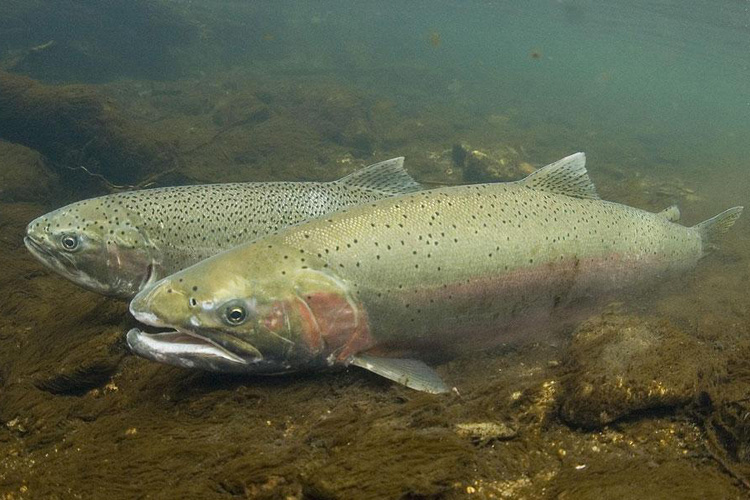Yesterday, a federal court approved a settlement agreement that will help the endangered Southern California Steelhead make a comeback in Santa Barbara County by allowing more water to flow into the Santa Maria River.
The settlement resolves a lawsuit filed in 2019 by environmental groups alleging that the operators of Twitchell Dam violated the Endangered Species Act (“ESA”) by cutting off the flow of water into important Steelhead habitat. Prior to the Dam’s construction, thousands of Steelhead migrated from the ocean to upstream spawning grounds. But without enough water, the fish become stranded in dry riverbeds, and the local population has cratered.
“For decades, the Dam’s operations have brought Steelhead to the brink of extinction in the Santa Maria River, and exposed Water District constituents to the costs of litigation. Now, that unlawful practice is coming to an end,” said Gordon Hensley of San Luis Obispo Coastkeeper.
The settlement requires, among other tasks, that the U.S. Bureau of Reclamation (“Reclamation”) modify the operation of the Dam, particularly the quantity and timing of water released into downstream rivers, to ensure endangered Southern California Steelhead have sufficient water for migration and ultimately for the species to recover.
The plaintiffs, San Luis Obispo Coastkeeper and Los Padres ForestWatch, are represented by the Environmental Defense Center, Sycamore Law, Inc., and Aqua Terra Aeris Law Group. The case alleged that the Dam’s operators were violating the ESA by limiting the quantity and timing of flows in the Santa Maria River to levels that harm the critically imperiled Steelhead population. The settlement sets forth a goal for the specific improved flow releases to be implemented in time for this migration season, January 10, 2024, ensuring Steelhead can reach their historic breeding grounds. The improved flows are based off a study required by law and conducted by Stillwater Sciences that demonstrated the amount of water necessary to provide flows of appropriate timing and magnitude for Steelhead would constitute only roughly 4% of the reservoir’s average annual amount of stored water.

“Today’s agreement brings us one step closer to a healthier river system that benefits fish, farms, and our communities,” said Los Padres ForestWatch executive director Jeff Kuyper. “It gives Steelhead a fighting chance to survive, just when they needed it most. We’re full of hope and excitement for the future of the Santa Maria River.”
“Releasing a minimal amount of water won’t harm water users, but it can bring back Steelhead populations in the Santa Maria River,” said Erica Maharg of ATA Law Group, who – along with Sycamore Law – represented San Luis Obispo Coastkeeper. “We’re looking forward to working with the Bureau of Reclamation as changes to the Dam’s operations work through the approval process.”
“This settlement is a huge step forward for the critically endangered Southern California Steelhead,” said Maggie Hall, Deputy Chief Counsel at the Environmental Defense Center, which represented Los Padres ForestWatch. “After facing decades of harm, Steelhead will finally have the opportunity to once again migrate up the Santa Maria River to important spawning habitat.”
Twitchell Dam was constructed in the 1950s, and is located on the Cuyama River, the northern tributary to the Santa Maria River. The operation of Twitchell Dam limits the timing and quantity of flows in the mainstem of the Santa Maria River, preventing Steelhead from migrating to and from the ocean and upstream spawning habitat, as this map depicts. Without adequate flows, fish are unable to complete this process and become stranded in the dry River system.
Seventy years ago, the Santa Maria River had the second largest Steelhead run in Santa Barbara County. By some estimates as many as 10,000 fish traveled up the watershed in wet years, with the Sisquoc River in the Los Padres National Forest being the most important spawning tributary within the stream network. However, several large dams have since blocked historic Steelhead runs. Now, Southern California Steelhead are one of the most endangered fish species in the United States. Steelhead are a keystone species for our region and an indicator of the health of our local waterways. This settlement is a big step in the path forward to recovering endangered Steelhead and protecting critical habitat and watersheds.
The settlement can be viewed here.
San Luis Obispo Coastkeeper is a non-profit public benefit corporation whose mission is to protect and enhance the water quality of the Central Coast area coastline, and its tributaries, including the Santa Maria River, for the benefit of its ecosystems and the surrounding human communities.
Los Padres ForestWatch protects wildlife, wilderness, water, and sustainable access throughout the Los Padres National Forest for the benefit of our communities, climate, and future generations. It seeks to enhance and restore the Santa Maria River watershed to support healthy fisheries and vibrant, resilient communities.
The Environmental Defense Center, a non-profit law firm, protects and enhances the local environment through education, advocacy, and legal action and works primarily within Santa Barbara, Ventura, and San Luis Obispo counties. Since 1977, EDC has empowered community-based organizations to advance environmental protection. EDC’s focus areas include protection of the Santa Barbara Channel, ensuring clean water, preserving open space and wildlife, and addressing climate and energy.
Sycamore Law is a public interest law firm that represents grassroots non-profits, tribes, and foundations in environmental advocacy and litigation. Sycamore’s areas of practice cover a broad range of environmental issues, including climate change and climate impacts, all elements of the water cycle (storm water, waste water, water diversions, groundwater), endangered species, land use, and toxics- all in support of sustainability and environmental justice.
Aqua Terra Aeris Law Group, a public interest law firm, is dedicated to protecting the California environment and the public health of all Californians, representing nonprofits, community groups, property owners, air districts, environmental justice communities and individuals impacted by pollution.















